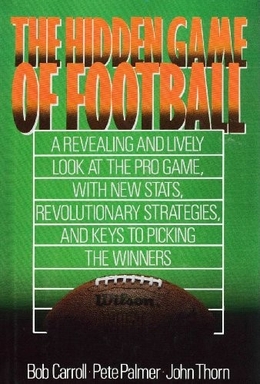Related Research Articles
On-base plus slugging (OPS) is a sabermetric baseball statistic calculated as the sum of a player's on-base percentage and slugging percentage. The ability of a player both to get on base and to hit for power, two important offensive skills, are represented. An OPS of .800 or higher in Major League Baseball puts the player in the upper echelon of hitters. Typically, the league leader in OPS will score near, and sometimes above, the 1.000 mark.

In sports analytics, sabermetrics is the empirical analysis of baseball, especially baseball statistics that measure in-game activity. Sabermetricians collect and summarize the relevant data from this in-game activity to answer specific questions. The term is derived from the acronym SABR, which stands for the Society for American Baseball Research, founded in 1971. The term "sabermetrics" was coined by Bill James, who is one of its pioneers and is often considered its most prominent advocate and public face.

George William James is an American baseball writer, historian, and statistician whose work has been widely influential. Since 1977, James has written more than two dozen books devoted to baseball history and statistics. His approach, which he termed sabermetrics in reference to the Society for American Baseball Research (SABR), scientifically analyzes and studies baseball, often through the use of statistical data, in an attempt to determine why teams win and lose.

The Society for American Baseball Research (SABR) is a membership organization dedicated to fostering the research and dissemination of the history and record of baseball, primarily through the use of statistics. The organization was founded in Cooperstown, New York, on August 10, 1971, at a meeting of 16 “statistorians” coordinated by sportswriter Bob Davids. The organization now reports a membership of over 7,000 and is based in Phoenix, Arizona.

Moneyball: The Art of Winning an Unfair Game is a book by Michael Lewis, published in 2003, about the Oakland Athletics baseball team and its general manager Billy Beane. Its focus is the team's analytical, evidence-based, sabermetric approach to assembling a competitive baseball team despite Oakland's small budget. A film based on Lewis' book, starring Brad Pitt and Jonah Hill, was released in 2011.

John A. Thorn is a German-born sports historian, author, publisher, and cultural commentator. Since March 1, 2011, he has been the Official Baseball Historian for Major League Baseball.
In baseball, defense-independent pitching statistics (DIPS) is intended to measure a pitcher's effectiveness based only on statistics that do not involve fielders. These include home runs allowed, strikeouts, hit batters, walks, and, more recently, fly ball percentage, ground ball percentage, and line drive percentage. By focusing on these statistics and ignoring what happens once a ball is put in play, which – on most plays – the pitcher has little control over, DIPS claims to offer a clearer picture of the pitcher's true ability.
Pete Palmer is an American sports statistician and encyclopedia editor. He is a major contributor to the applied mathematical field referred to as sabermetrics. Along with the Bill James Baseball Abstracts, Palmer's book The Hidden Game of Baseball is often referred to as providing the foundation upon which the field of sabermetrics was built.

Baseball Prospectus (BP) is an organization that publishes a website, BaseballProspectus.com, devoted to the sabermetric analysis of baseball. BP has a staff of regular columnists and provides advanced statistics as well as player and team performance projections on the site. Since 1996 the BP staff has also published a Baseball Prospectus annual as well as several other books devoted to baseball analysis and history.
A clutch hitter is a baseball player who is seemingly adept at getting a hit in high-pressure situations, i.e. in the clutch. This usually refers to getting a hit when the player's team is trailing late in a game and needs to score to tie or take the lead, especially if there are already two outs in the inning and/or the batter already has two strikes. That said, a clutch hit can occur at any point in the game if the circumstances are similarly high-stakes. Establishing a reputation as a clutch hitter is desirable for a player. Although clutch hits are recorded no differently than any other hit for statistical purposes, the notion that a player is more likely to produce clutch hits compared to other players can be advantageous in contract negotiations.
Keith Woolner is an author for Baseball Prospectus and is the creator of the statistic Value Over Replacement Player (VORP). VORP is acknowledged by the sabermetrics community as one of the key concepts in the analysis of a player's performance and market valuation.
Total Sports Publishing refers to a book publishing company based in Kingston, New York, that operated from 1998 to 2002. Prominent author John Thorn served as the division's publisher throughout its existence.
Robert Nuehardt Carroll Jr. was an American sportswriter and sports historian.
PECOTA, an acronym for Player Empirical Comparison and Optimization Test Algorithm, is a sabermetric system for forecasting Major League Baseball player performance. The word is a backronym based on the name of journeyman major league player Bill Pecota, who, with a lifetime batting average of .249, is perhaps representative of the typical PECOTA entry. PECOTA was developed by Nate Silver in 2002–2003 and introduced to the public in the book Baseball Prospectus 2003. Baseball Prospectus (BP) has owned PECOTA since 2003; Silver managed PECOTA from 2003 to 2009. Beginning in Spring 2009, BP assumed responsibility for producing the annual forecasts, making 2010 the first baseball season for which Silver played no role in producing PECOTA projections.

In baseball, a closing pitcher, more frequently referred to as a closer, is a relief pitcher who specializes in getting the final outs in a close game when his team is leading. The role is often assigned to a team's best reliever. Before the 1990s, pitchers in similar roles were referred to as a fireman, short reliever, and stopper. A small number of closers have won the Cy Young Award. Eight closers have been inducted into the Baseball Hall of Fame: Dennis Eckersley, Rollie Fingers, Goose Gossage, Trevor Hoffman, Mariano Rivera, Lee Smith, Bruce Sutter and Hoyt Wilhelm.
In baseball statistics, run average (RA) refers to measures of the rate at which runs are allowed or scored. For pitchers, the run average is the number of runs—earned or unearned—allowed per nine innings. It is calculated using this formula:
Earnshaw Cook was an early researcher and proponent of sabermetrics, the analysis of baseball through statistical means.

Total Baseball was a 2,301 page baseball encyclopedia first compiled by John Thorn and Pete Palmer in 1989. By its fourth edition, Major League Baseball endorsed it as its official encyclopedia. The encyclopedia contains seasonal and career statistics in numerous categories for every Major League player, as well as historical, opinion, and year-by-year essays. Thorn wrote one of the chapters and edited the rest while Palmer, in collaboration with Thorn, provided the statistics.

The Hidden Game of Football: A Revolutionary Approach to the Game and Its Statistics is a book on American football statistics published in 1988 and written by Bob Carroll, John Thorn, and Pete Palmer. It was the first systematic statistical approach to analyzing American football in a book.

Jonah Keri is a Canadian former journalist, sportswriter, and editor. He is currently serving a prison sentence after pleading guilty to multiple counts of domestic violence offences.
References
- ↑ John Thorn and Pete Palmer, with David Reuther, The Hidden Game of Baseball, 1984. New York: Doubleday & Company, 1984
- ↑ Thorn, John (April 20, 2015). "The Hidden Game of Baseball, 2015". MLB.com.
- ↑ Keri, Jonah; Prospectus, Baseball (2007-02-27). Baseball Between the Numbers: Why Everything You Know About the Game Is Wrong. Basic Books. pp. 2, 43. ISBN 978-0-465-00373-0.
- ↑ [John Thorn, Pete Palmer, with David Reuther, The Hidden Game of Baseball Chicago: The University of Chicago Press, p. x.
- ↑ Keri, Jonah; Prospectus, Baseball (2007-02-27). Baseball Between the Numbers: Why Everything You Know About the Game Is Wrong. Basic Books. pp. 61, 128. ISBN 978-0-465-00373-0.
- ↑ Golden, Bruce L.; Wasil, Edward A. (1986-02-01). "Book Review of the Hidden Game of Baseball: A Revolutionary Approach to Baseball and its Statistics by John Thorn and Pete Palmer". American Journal of Mathematical and Management Sciences. 6 (3–4): 423–428. doi:10.1080/01966324.1986.10737202. ISSN 0196-6324.
- ↑ "8 new baseball books for Opening Day and beyond". Christian Science Monitor. ISSN 0882-7729 . Retrieved 2022-11-17.